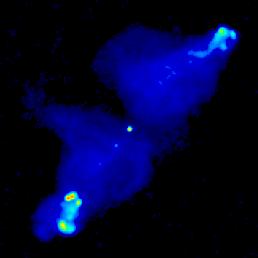 Image:
Image:
Click on the image for a full-sized version.
The bright central point is the radio core. The faint point south-east
of the core is elongated at higher resolution
(Hardcastle et al. 1997) and is presumably
the brightest part of a jet. The south-east hotspot complex boasts four
distinct peaks. The jet points to the one closest to the core, which is
also the most compact (Hardcastle et al.), so this seems to be the current
impact point of the jet. Unfortunately even Hardcastle et al's image leaves
it hard to imagine the fluid flows that could lead to the rest of this
structure.
Hardcastle et al. show that the outer component of the north-west hotspot
complex is a thin rim along the outer edge of the lobe, which is probably
the impact point on that side; the rest of the north-west structure should
then be due to material flowing back into the lobe.
The distortion of the inner south-east lobe towards the north-east
seems to be part of a large coherent ring perpendicular to the DRAGN axis,
suggesting a huge eddy within the lobe.
4C 14.11 was added to the 3CRR sample by
Laing, Riley & Longair (1983) as its
flux in the more accurate 4CT survey was high enough that it should
have been included in 3CR. Most likely it was omitted simple due
to random errors in 3CR. A side effect is that it has not been studied as
intensively as other sample members (e.g. there are no HST images).
Page created: 2009 Apr 2 14:16:42
J. P. Leahy
jpl@jb.man.ac.uk
 Image:
Image: